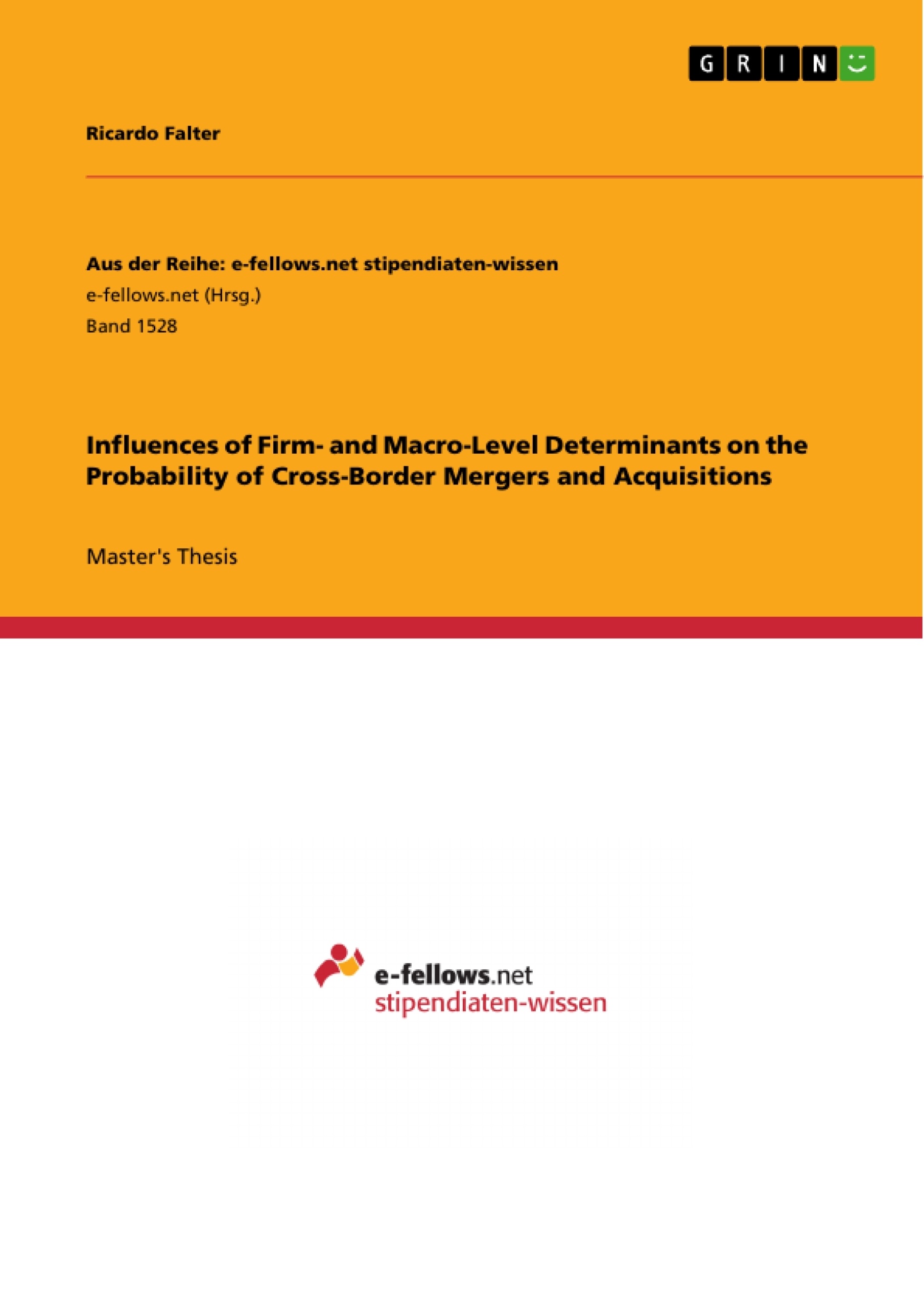While the influences of macro-level determinants on cross-border transactions have been investigated in several studies before, firm-level determinants have mostly been excluded in those studies. This study finds that firm-level determinants have a substantial influence on the probability a firm’s decision to acquire a company in a foreign country. The result is even more pronounced in transactions where the acquirer’s and the target’s business operations are related to each other. In unrelated transactions, it was found that acquirers are more influenced by domestic and foreign stock market valuations as well as the relative value of their currency. This seems to proof the fire-sale theory as well as the risk reduction through diversification theory. It is concluded that unrelated transactions are more opportunistic, while related transactions are based on firm-specific business strategic reasons. A firm’s amount of excess cash has been included as a firm-level determinant into the probit model of this study. This variable is fairly new to this kind of studies and its results offer deeper insights into the relationship between transaction probability, determinants and relatedness. This study extents the existing body of academic literature on cross-border mergers and acquisitions by investigating firm- as well as macro-level determinants, while simultaneously taking the relatedness between the transaction parties into account. In order to verify the results, further research into this area is strongly encouraged.
Inhaltsverzeichnis (Table of Contents)
- Introduction
- Literature Review
- Macro-Level Determinants of Cross-border M&A and General FDI
- Exchange Rates
- Institutions
- Taxation
- Firm-Level Determinants
- General FDI determinants
- Asset Intangibility
- Firm Size
- Domestic M&A Determinants
- Relatedness
- Economic Growth
- Stock Market Growth
- Excess Cash
- General FDI determinants
- Summary of Determinants
- Macro-Level Determinants of Cross-border M&A and General FDI
- Conceptual Framework
- Methodology
- The Model
- Data Retrieval and Methodology
- Firm-Level Variables
- Macro-Level Variables
- Data Overview and Descriptive Statistics
- Descriptive Statistics
- Results and Discussion
- Fit of the Models
- Robustness Checks
- Conclusion
- Limitations
Zielsetzung und Themenschwerpunkte (Objectives and Key Themes)
This study focuses on investigating the influence of firm- and macro-level determinants on the probability of cross-border mergers and acquisitions (CBAs). It aims to contribute to the existing body of literature by including firm-level determinants while simultaneously considering the relatedness between the transaction parties. The study seeks to determine the extent to which firm-specific characteristics impact a firm's decision to acquire a company in a foreign country.
- Impact of firm-level determinants on cross-border M&A probability
- Comparison of related and unrelated transactions
- Influence of macro-level determinants on cross-border M&A
- Relationship between transaction probability, determinants, and relatedness
- Extension of existing research on cross-border M&A
Zusammenfassung der Kapitel (Chapter Summaries)
- Introduction: This chapter introduces the topic of cross-border mergers and acquisitions (CBAs) as a means of growth for companies seeking to expand their operations. It highlights the increasing importance of CBAs in the globalized business environment and discusses the existing literature on both general and domestic M&A, as well as foreign direct investment (FDI). The chapter argues for the need to investigate firm-level determinants of CBAs, drawing on theoretical frameworks such as the industrial organization theory and the transaction cost theory.
- Literature Review: This chapter provides a comprehensive overview of the existing literature on macro-level determinants of CBAs and general FDI, including exchange rates, institutions, and taxation. It also explores firm-level determinants of FDI and domestic M&A, such as asset intangibility, firm size, relatedness, economic growth, stock market growth, and excess cash.
- Conceptual Framework: This chapter presents the conceptual framework used in the study, outlining the relationship between firm- and macro-level determinants and the probability of cross-border M&A. It discusses the distinction between related and unrelated transactions and how different determinants may influence each type of transaction.
- Methodology: This chapter details the methodology employed in the study. It describes the model used to analyze the data, the data retrieval process, and the specific firm- and macro-level variables included in the analysis. The chapter also provides an overview of the data and descriptive statistics.
- Results and Discussion: This chapter presents the results of the study, analyzing the fit of the models and conducting robustness checks. It discusses the findings regarding the influence of both firm- and macro-level determinants on the probability of cross-border M&A and explores the differences between related and unrelated transactions.
Schlüsselwörter (Keywords)
The study focuses on cross-border mergers and acquisitions (CBAs), firm-level determinants, macro-level determinants, relatedness, transaction probability, excess cash, industrial organization theory, transaction cost theory, and resource-based view (RBV).
- Citation du texte
- Ricardo Falter (Auteur), 2015, Influences of Firm- and Macro-Level Determinants on the Probability of Cross-Border Mergers and Acquisitions, Munich, GRIN Verlag, https://www.grin.com/document/303536



